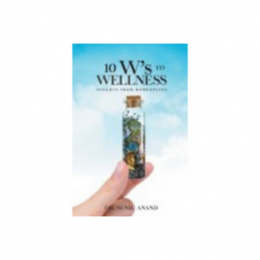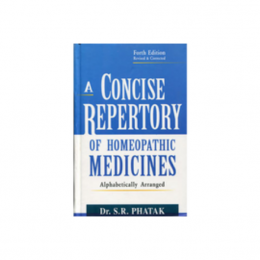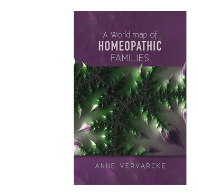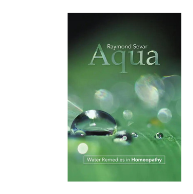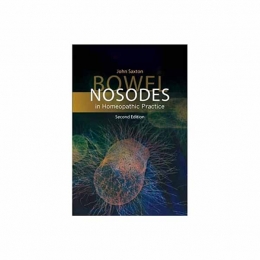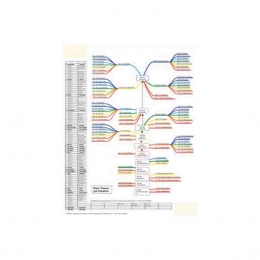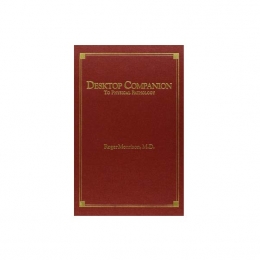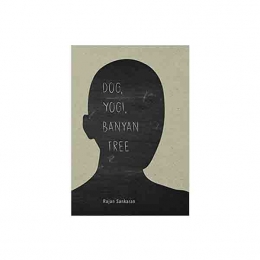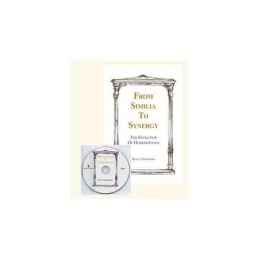A Concise Repertory of Homeopathic Medicines - Fourth Edition, Revised and Corrected - S R Phatak
Alphabetically arranged.
An ideal repertory for the beginners and for those who believe in artistic prescribing. The simplest & handy repertory in alphabetical order. Remedies for a particular rubric are reduced to minimum possible by careful selection. Makes drug selection easier, simpler and efficient. A Repertory students can use for their first cases they wish to prescribe for. In this repertory, the headings include Mentals, Generals, Modalities, Organs, and their Sub-parts; all arranged in the alphabetical order. Physiological and pathological conditions have also been included. Cross references are given wherever necessary.
Enlarged, improved version with additions from standard books and repertories like - Boericke, Kent, BTPB, Dr Clarke’s dictionary, etc.
Inclusion of accurate clinical observations and experiences
Contains pathological entities and rubrics even missed in the Kent’s repertory
Generalization concept of Dr Phatak has been highlighted. General modalities mentioned as AGG. and AMEL., whereas particular modalities have been distinguised as agg. and amel.
Dr. S.R. Phatak, as master prescriber in the field of homeopathy. He has contributed immensely to homeopathic literature. His books are available in three languages - English, Hindi and Marathi. His book ‘Materia Medica’ is very popular both amongst the students and practitioners. His books gives us an insight into the philosophy and practice of this remarkable homeopath. His literature is enriched with his own accurate clinical observations and experiences.
462 pages, paperback
A World Map of Homeopathic Families by Anne Vervarcke
A World Map of Homeopathic Groups and Families aims to make homeopathic practice manageable again. Unlike the early days of homeopathy and particularly in the last 20 years, homeopathic students and practitioners now have access to a bewildering amount of information - new provings, books, systems and computer programmes all add to an already extensive body of knowledge. But how does the practitioner incorporate all this new data into their work? This book aims to answer this question by guiding us to take a step back from a case for a more 'big picture' view before examining the smaller details. It introduces the concepts of 2D / 3D groups and the Vital Approach Map of Homeopathic Families which Anne likens to a treasure map for the similimum. Practitioners will learn how to identify clear pointers for the bigger groups and families, what other key information to look for in a case, how to connect the dots and recognise patterns leading to more efficient prescribing and improved outcomes. Anne's straightforward approaches are beautifully presented in this book. Through them we gain not only a broader perspective but also deeper understanding that allows our homeopathic practice to be taken to a whole new level.
About Potencies- Plouvier-Suijs Margot
Here you see the result of a great and thorough work: an important book in homeopathy’s growth to maturity.
Margriet Plouvier has created an extremely workable overview of the functioning of different potencies by systematically and logically arranging her observations of the therapeutic effect after prescriptions. This is a great support when we try to choose the appropriate potency for a case.There are many theories about the use of the best potency, but until now it is more tradition and conviction that are determinative instead of systematic research. Being the pharmacist of a homeopathic pharmacy, I see many recipes every day; so I have an overview of many prescriptions. I also have knowledge of clinical and fundamental research in homeopathy: this research doesn’t show any useful difference of result between D, C, K, or LM potencies.Very little study has been done into the exact differences in functioning between the several potency-systems. It is impossible to have a preference based on clinical and fundamental research. Nevertheless I notice that doctors and therapist have their strong personal preferences. This book shows the corresponding effect of potencies from different potency- systems.
The question is: what is most important? Is the difference in effect of the several potencies secondary to the choice of the simillimum in the potency appropriate to the case?
Allen's Keynotes
The work of a homeopathic student while studying and applying materia medica is one to constantly compare and differentiate. He must compare the pathogenesis of a remedy with the recorded anamnesis of the patient; he must differentiate the apparently similar symptoms of two or more medicinal agents in order to select the simillimum. To enable the student or practitioner to so this correctly the student must have proper knowledge of the individuality of the remedy; something that is peculiar, uncommon, or sufficiently characteristic in the polychrest remedy that may be used as a pivotal point of comparison. This pivotal point may be a 'keynote', a 'characteristic', or the 'red strand of rope'. This excellent work by Dr. H.C. Allen helps the reader to grasp the PQRS symptoms in no time.
Alternation of Remedies In Homoeopathic Therapeutics- Tahir Malik Awan
Homoeopathy is a system of medicine which has penetrated through the world of health and disease as an icon built on solid principles as its foundation. It has proved itself to be worthy of consideration with the other branches of medical science. I do not think that it needs any umbrella, as of alternative medicine. In fact, it is a complete system with its paraphernalia and has its own individual identity, which is being admitted strongly in the last few decades as an art and science.
During the advance study of homoeopathic philosophy one often comes across new enigmas and have wonderful experiences. Alternation of homoeopathic remedies is one of them. In the history of homoeopathic therapeutics, it is a ground reality that there are miracles in single remedy prescription but on many occasions and under undecidable and complicated situations, alternation of remedies is also full of magical results. Various examples of alternations done by renowned homoeopaths could be found as a reference in the introduction and the main part of this book.
Alternation of remedies is a part and parcel of homoeopathic therapeutics. Alternation is not a matter of mixing remedies. It is always giving one remedy at a time and giving other after a lapse of time depending upon the conditions and requirement of the case. I should say that alternation is a cross between two or more required remedies or a point where the tips of these two or even three remedies meet. It is a converging point where the cure meets the disease and sure it is.
Hahnemann has generally advised to give single remedy and strictly prohibited and condemned the prescription of more than one remedy at a time or mixing them altogether. It has never occurred once or mentioned anywhere that he has strongly prohibited the alternation of remedies. Despite the continuous best efforts when we are not getting the required results and the condition of the patient and intuition of the physician is pointing toward alternation then we must not hesitate to alternate.
Hahnemann himself did alternation when he considered it as a necessity, for the betterment of the patient or curing of the disease i.e. be it a miasmatic situation or complications arising from miasmatic complexities.
From the first edition of “Organon of the Rational System of Medicine”, throughout the evolutionary process, till it reaches the zenith of 6th edition of “Organon of Medicine”, Hahnemann’s thoughts had been oscillating between acceptance and rejection of alternation of remedies. I have not done this work to justify the practice of alternation of remedies. It is just an effort to assimilate the scattered therapeutical material, on and about alternation by different legendary homoeopaths in the literature available , from the Hahnemannian era to the present times.
I again emphasize that alternation of remedies should not be adopted as a regular practice. It must be used when its need is inevitable and where the totality is indicating the two or more remedies at a time.
Aqua by Raymond Sevar
Water is astonishing: ocean, glacier, snowflake, rainbow and essential to every living thing on our planet. This book presents the Aqua as a coherent family of homeopathic remedies with clearly defined themes, keywords, vital sensations & symptom patterns. The symptom patterns vary with the degree of mineralisation, from the highest (Dead Sea Water and Aqua Marina) to the lowest (Aqua Destillata - distilled water), yet the themes and vital sensations remain the same. We all use water words that encapsulate what water is and does and means to us. Water words are embedded in our psyche and our cultures, yet those who need an Aqua remedy use them much more frequently than others, especially to describe their symptoms. This book lists the water words to listen out for during a consultation. A chapter on related remedy families shows the varying degrees of relationships with single remedies & families, the closest being Fish, Gemstones, Lanthanides, Sarcodes, Birds, Energy (aka ‘Imponderables’) and Asteraceae. Clinical cases are presented throughout and useful heuristics with the most common clinical presentations of illness in Aqua cases are highlighted. The chapter on Aqua and the Miasms illustrates each miasm with its Aqua words.
Behind the Glass Screen - A Homeopathic Survey of Ozone - Anne Vervarcke, 2009
‘Ozone is an essential element of life and Anne Vervarcke’s book, “Behind the Glass Screen: A Homeopathic Survey of Ozone,” is an essential tool for finding Ozone cases in your practice. The extensive research of the substance, Anne Schadde’s proving, and clearly analyzed cases using the Sensation Method make this remedy easy to identify and prescribe. This book is a must-have Materia Medica for your library.’
—Burch, Melissa, CCH, RsHom(NA)
‘The book ozone is like a complete capsule of information about the source as well as the clinical side of ozone. Anne is a good friend and a sensitive homeopath. We hope her hard work helps many readers to pick Ozone cases. They shall now be easy to recognize and not so elusive and distant like the gas itself.’
—Bhawisha & Joshi, Shachindra
‘This book is about ozone, ozone and ozone. There are three stages to this lucid and compelling book. There is the introduction to ozone in the world and in the environment, setting the stage, and then there is a magnificently crafted materia medica picture drawing upon the proving by Anne Shadde and related materia medica as the centrepiece, and then there is a series of compelling cases to illustrate the remedy used in reality. All this is within the modern context of the vital sensation which is reviewed sufficiently so there was a clear framework. By reading this book, you will have both an enjoyable read, and you will be able to introduce ozone into your practice and fill one huge gap in materia medica that has been missing for far too long.’
—Chappell, Peter, FSHom
‘This book is a welcome addition for homeopaths. It confirms the Periodic system analysis and the provings of Ozone. The central role of Oxygen in our Earth system and in the global warming makes this book very interesting.’
—Scholten, Jan
‘Anne Vervarcke’s book Ozone draws on a wide range of resources. She gives a clear chemical understanding of both Ozone and Oxygenium, and weaves together the ideas, hypothesis, insights and intelligence of many modern homeopaths. The book is crowned by Eight Ozone and three Oxygenium cases, many from her own practice, and her method, the AV Method of anamnesis and analysis is explained and used throughout. If you want to understand Ozone, one of the most undervalued remedies of our time, this is the book that says it all.’
—Tree, Jenni
Anne Vervarcke who was trained in Bloemendaal and Amersfoort has a private clinic since 1989. She has been teaching since 1990, in the CKH which she established, and since a few years she is giving seminars in different countries. In Belgium she gives a Post Graduate lectures once a month with live cases. After attending countless seminars, investigating, practicing and teaching for over 15 years, she fully masters the art of homeopathy.
In 1999 she publishe: “Klassieke homeopathie: niet te goloven?!’ and in 2005: ‘250 jaar na Hahnemann’, both in Dutch. She also has another book titled ‘The Charm of Homeopathy’ published by B. Jain Archibel, which is a commentary on problems faced in clinical practice and solutions to them.
174 pages, paperback
Beyond Flat Earth Medicine - An Introduction for Students and Patients - Timothy R Dooley
People today are rediscovering homeopathy, yet few understand this individualized approach to health and disease. Dr. Dooley brings over 25 years of training and experience in a wide range of health sciences to this novel introduction to homeopathy – what it is, how it differs, when to use it, what to expect, how to get results.
“Conventional medicine is ‘flat earth’ in that it approaches health problems from the perspective of the disease instead of the patient. Just as the earth appears flat and the sun appears to revolve around the earth, so also it appears that physicians treat patients when treating their diseases. This is not true! AS you will see, it is possible to treat the patient directly, as a whole.”
Dr. Dooley is a graduate of National College of Naturopathic Medicine as well as Oregon Health Sciences University School of Medicine. He was a co-founder of Grants Pass Naturopathic Clinic in Oregon, medical director of emergency services at Del Puerto Hospital in California, and volunteered with Ananda Marga Universal Relief Team in Mexico and India. He is on the faculty at Southwest College of Naturopathic Medicine and writes a monthly self-care column in Homeopathy Today. He lives with his family in San Diego, California where he practices Homeopathy.
110 pages, paperback
Birds - Joshi
Cases that elaborate the system Homeopathic Classification of nearly 9000 birds Understanding of over 250 bird families More than 500 bird species explained All birds families with their unique numbers and key words Birds with their unique columns nos. to differentiate better Key words for easy differentiation Quick reference charts List of current bird remedies available around the world
Bowel Nosodes in Homeopathic Practice (3rd Edition) by John Saxton
The group of eleven homeopathic remedies known as the Bowel Nosodes are unique in both their derivation and the opportunities that they offer. Although they have some indications in acute prescribing, because of the connection and resonance that they have with the miasmatic forces that are active in the body, they are particularly useful in the treatment of chronic disease. The origin of these remedies lies in human medicine, and there are still major indications in that field. Their development is traced and the concept behind them is explained and discussed within the context of modern homeopathic thought. The general uses of the group in the clinical situation are outlined, and the materia medica of the individual bowel nosodes is discussed. The various methods of using the bowel nosodes are illustrated with nine case histories from the human world and ten from the animal, demonstrating the common guidelines that are applicable to all species. The third edition is revised, expanded and updated.
Bowel Nosodes in Homeopathic Practice 2nd ed - John Saxton
The group of eleven remedies known as the Bowel Nosodes are unique in both their derivation and the opportunities that they offer. Although they have some indications in acute homeopathic prescribing, because of the connection and resonance that they have with the miasmatic forces that are active in the body, they are particularly useful in the treatment of chronic disease. The origin of these remedies lies in human medicine, and there are still major indications in that field.
In this book the development of these important remedies is traced and the concept behind them is explained and discussed within the context of modern homeopathic thought. The general uses of the group in the clinical situation are outlined and the materia medica of the individual bowel nosodes is discussed. The methodology is illustrated with case histories from both the human and animal worlds, demonstrating the common guidelines for the bowel nosodes’ use that are applicable to all species.
John Saxton qualified from the Royal Veterinary College in 1964, obtaining his Membership of the Faculty of Homeopathy in 1988, and his Fellowship in 1996. After nearly forty years in general practice he now runs a homeopathic referral practice as well as writing, teaching and examining in homeopathy. He lectures nationally and internationally to doctors, veterinary surgeons and nurses, both independently and as part of the Homeopathic Professionals Teaching Group. John is a teacher and examiner for the Faculty of Homeopathy and the International Association for Veterinary Homeopathy. He has authored Miasms as Practical Tool and co-authored the Textbook of Veterinary Homeopathy.
185 pages, paperback
Carbon Chart - Roger Morrison, 2006
Quick reference chart to accompany his book Carbon: Organic and Hydrocarbon Remedies in Homeopathy, see below in related products.
Cards Plant theory - map - Jan Scholten
The Mindnode at one side and the other table at the other.
Laminated card, 2 sided
Cola - Homeopathic Proving of Cola nitida, Materia Medica, Cases - Bernd Schuster, 1999
The new remedy Cola belongs to the group of drug remedies. Drugs are often used to heighten or expand perception, to enable the user to cross boundaries which Nature has set to the human powers of perception. The drugs cannabis, coca (“sacred plant of the Incas”), cola (“food of the gods”) and peyote (“flesh of God”) are seen as “divine substances” which create a link with the gods and spirits.
This full Hahnemannian proving with 23 participants revealed feelings of invincibility, the idea of being able to carry the whole world on one’s shoulders, or being able to see through the material person into the innermost being or read a person’s thoughts, i.e. mainly divine qualities and abilities which the provers ascribe to themselves, thus demonstrating a delusion of grandeur.
Insatiability is a central idea of the remedy (“I am like a bottomless pit”). The new remedy shows and effect in eating disorders (Insatiability and fear of being poisoned), mania and hyperactivity, disturbance of sugar metabolism, gastrointestinal illness with diarrhoea, problems with self-confidence, depression, sleepiness (fatigue), anxiety dreams and migraine. In Cola patients I have found a history of drug-taking with heroin, LSD and cocaine, a history of dipsomania or food abuse with others.
Bernd Schuster is classical homeopath and psychologist. With Bamboo he added an important remedy to homeopathic Materia Medica. Cola is his second homeopathic proving.
305 pages, paperback
Concordant Reference 2nd ed- Vermeulen
The world's best single-volume materia medica has been completely revised and updated - for instance, Vermeulen's Concordant Reference now includes ALL of Boericke's remedies precisely indexed and easy to find.
Those who are already familiar with Vermeulen's original Concordant Materia Medica will find the familiar layout of sections, symptom divisions and categories in this new Concordant Reference.
Professional homeopathic practice without the Concordant Reference is inconceivable.
Concordant Reference, published November 2011
- 1209 remedies in one book!
- An additional 362 remedies from the classical materia medicas
- Expanded Sensation, Mind and Dream sections
- Family Information on Plants, Animals, Fungi, Bacteria and Viruses
- Chemical Formulas for Mineral and Organic Compounds
- Standardized Nomenclature with latin names, common names and family groupings
- Corrected source material information from the author's research
- Remedies described separately that had been combined in the classical literature
- More proving symptoms to complement the clinical focus of the previous versions
- Organized in Boericke's scheme but including material from ten classical authors
Do you, like so many homeopaths, spend your days in and out of Frans Vermeulen's books? If so, then you know that Vermeulen's materia medicas are the most comprehensive single-volume references available. The original Concordant met with instant success on its publication 17 years ago. Now, for the first time in 14 years, this information has been completely revised, expanded and updated.
Concordant Reference represents an extensive sifting and culling of the classical homeopathic materia medica. Remedy source information has been corrected from the original texts. Previously combined remedies, like Rhus toxicodendron and Rhus radicans, have been distinguished and listed separately. More proving symptoms have been included from T.F. Allen's Encyclopedia to complement the mostly clinical information from Hering.
Our lesser known remedies benefit most from Vermeulen's work on Concordant Reference. In particular, dozens of substances previously hidden in the "relationship" sections of Boericke's Pocket Manual have been either indexed or separated into their own listings. Experience shows that small or previously unknown remedies can yield brilliant results. Modern homeopaths will have the opportunity to examine these additional remedies and broaden their use.
Besides the expanded and verified content, the new Concordant Reference reflects recent changes in homeopathic techniques and scientific knowledge. By improving the accuracy of the original material and adding scientific classification, Concordant Reference uses the classical materia medica to build a solid foundation for the modern practice of homeopathy.
The phrase, "classical materia medica," refers to the work done from 1790 - 1931, starting with Hahnemann and ending with Boericke and Boger. Concordant Reference is a one-volume compilation of the following classical materia medicas:
1) T.F. Allen - Encyclopedia of Pure Materia Medica, 10 volumes (1874 - 1879)
2) T.F. Allen - A Primer of Materia Medica (1892)
3) Boericke - Pocket Manual of Homeopathic Materia Medica (1927)
4) Boger - Synoptic Key of the Materia Medica (1931)
5) Clarke - Dictionary of Homeopathic Materia Medica, 3 volumes (1900)
6) Cowperthwaite - Textbook of Materia Medica and Therapeutics (1891)
7) Hering - Guiding Symptoms, 10 volumes (1877 - 1887)
8) Kent - Repertory (1877)
9) A. Lippe - Textbook of Materia Medica (1865)
10) Pulford - Homeopathic Materia Medica of Graphic Drug Pictures (approx. 1930)
Those who are already familiar with Concordant Materia Medica will find the familiar layout of sections, symptom divisions and categories in Concordant Reference. Each remedy's materia medica is broken down into Generals, Mind, Dreams, Body sections, Modalities, Relations and Causation. The author has broken out sections on Food and Drink, Heart, Limbs in General, Upper Limbs and Lower Limbs for easier reference. Also, each section of the body is further divided into Sensations, Pain and Objective.
Vermeulen has enlarged the Sensation, Mind and Dream sections, reflecting the recent developments in case taking, case analysis and prescribing that have shown to be so effective for today’s homeopath.
Costa Rica Provings - Scholten
Costa Rica proving describes the fifth proving seminar in Costa Rica. It turns out that the proving are getting better over the years. The quality of the proving is becoming more accurate and the essence of the remedy is discovered amore or less broadly. The provers get the Remedy code partially or totally from the proving. The Remedy code is the code as developed in the Plant theory which has been published in Wonderful plants. It is astonishing how accurate they often find the Remedy code, partially or totally. The proving show often new aspect of the remedy or family to which it belongs. In these proving the two remedies from the Piperaceae showed strongly the aspect of the neglect child, but then in a more general way. It showed that the western culture of laying babies in their own bed, far away from the parents is a cultural problem, reflected in the Piperaceae.
Dental Prescriber by Colin Lessel
Published on behalf of the Homeopathy UK charity, this popular booklet contains guidance for the homeopathic treatment of acute conditions affecting the mouth, gums and teeth. It should appeal to both professionals and patients alike. First Published by the British Homeopathic Association in 1983, this booklet has been reprinted 1993, 2009, 2017 and now 2021. Available singly to retail clients. Packed in 5s for trade, each pack representing one book unit.
Desktop Companion to Physical Pathology - Roger Morrison, 1998
Excerpt from Introduction: As with my first book, Desktop Guide to Keynotes and Confirmatory Symptoms, I have embarked upon the writing of this text because I wanted it for my own practice. I have tried to create a concise yet thorough differential for each of the main pathologies encountered in homeopathic practice. It is my hope that the present book will serve as a companion to my earlier book.
My main concern throughout the writing of this books has been that its purpose and the information it contains would be misconstrued and misused. Homeopathy is an art and a science which must always aim to cure the patient on the deepest level. In this aim, often it is the deepest inner conflicts and frustrations of our patient which lead us to the correct remedy. The practitioner must always consider the whole person. In fact, many cases the constitutional remedy cures a pathology for which it is not listed in our materia medica. Since this is so, what is the purpose of writing a therapeutic text which by its name emphasizes the physical symptoms and keynotes?
I wish therefore, to be clear about my intentions in putting forth this material. The purpose of this book is threefold: It is meant first as an aid to be used at the time of patient interview (either by phone or in person) to cue the practitioner toward likely remedies for a particular condition. The second purpose is as a study guide, bringing the main points of the remedies into focus. And, finally, to give advice about treatment based on the experience of myself and my colleagues at our center.
605 pages, hard cover
Discovering Homeopathy - Your Introduction to the Science and Art of Homeopathic Medicine - Dana Ullman, 1991
Discovering Homeopathy is a revised, updated edition of Homeopathy: Medicine for the 21st Century.
"The important concepts of homeopathy should be studied most seriously not only by those in medicine but in all social sciences. Dana Ullman's book is an eye-opener!"
-Robert Muller, Former Assistant Secretary-General of the United Nations
"Too often books on alternative medicine resort to doctor-baiting and mellow-speak psychobabble. This book does neither. The author states his case for homeopathy well by citing numerous double-blind laboratory and clinical studies that merit the attention of medical professionals and the general public alike."
-Marvin McMillen, M.D., Ph.D., Assistant Professor of Surgery, Yale Medical School
"In the future, comprehensive health care will require an efficacious balance between allopathic, behavioral, and homeopathic interventions. By documenting the double-blind research concerning homeopathy and its clinical significance, Discovering Homoeopathy: Medicine for the 21st Century represents a landmark book in establishing this vital synthesis."
- Kenneth R. Pelletier, Ph.D., Associate Clinical Professor, U.C.S.F. School of Medicine, and health consultant to IBM, AT&T, Xerox, and other major corporations
"The time has come to look again at even more basic ideas of the nature of living things in the light of recent advances in biology, physics, and electronics. I believe that this approach will provide verification for therapies such as homeopathy. Discovering Homoeopathy: Medicine for the 21st Century presents a clear, concise, and fascinating review of the present status and scope of homeopathy for the general reader."
- Robert Becker, M.D., orthopedic surgeon, author of The Body Electric and Cross Currents
277 pages, paperback
Free as a Bird - Kuntosch
In recent years the bird remedies have swooped down, conquering homeopathic practice. They are remedies for our times and are indicated in people who, like the Lanthanides, are seeking freedom and self-realisation yet at the same time have a strong sense of duty towards their family. They tend to sacrifice themselves to this task, consequently feeling too restricted by their duties. Physically this is most often expressed in stubborn states of tension in the neck, shoulder and chest, together with an inner feeling of tenseness and restlessness. After a comprehensive introduction to the general characteristics by which bird patients can be identified, the author presents a series of impressive case histories, some with severe pathology. Along with the familiar Bald Eagle (Haliaeetus leucocephalus) and Peregrine Falcon (Falco peregrinus disciplinatus), there are also descriptions of unfamiliar bird remedies such as Red Kite (Milvus milvus), Northern Goshawk (Accipiter gentilis), Chicken (Gallus gallus), European Robin (Erithacus rubecula) and Magpie (Pica pica).
From Similia to Synergy - The Evolution of Homeopathy - Rajan Sankaran
From Similia to Synergy guides the reader through the full spectrum of homœopathic knowledge. Dr Sankaran demonstrates integration with actual case studies. Case-taking discourses have been transcribed and parsed to allow the reader to understand Sankaran’s thought processes. This has been an evolutionary process, described through his various publications spanning The Spirit of Homœopathy to The Synergy in Homoeopathy.
This is a book that will help you produce solid and definite successful results in practice.
474 pages, hardcover (includes 2 DVDs)
Hahnemann's Legacy in Modern Homeopathic Practice - Saxton
Modern homeopathic practice, whilst moving into new and exciting areas, is still based on the three great works of Hahnemann - the Organon, Chronic Diseases and Materia Medica Pura.
Yet these pillars of practice are themselves based on the years of doubts, observation, thoughts and experimentation which are revealed in Hahnemann's other writings and letters. To fully understand and utilise the modern developments, it is necessary to appreciate where the true roots of modern homeopathy lie.
Many of the problems facing homeopathy today were also faced by Hahnemann and his followers. This book will examine the growth of homeopathy within the context of Hahnemann's legacy that continues to inform today's practitioners and guide the development of their practice.

